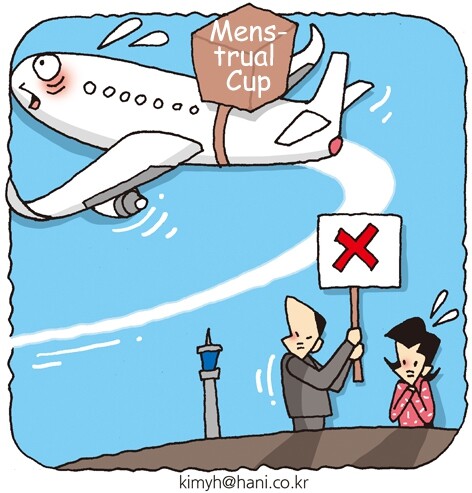hankyoreh
Links to other country sites 다른 나라 사이트 링크
Women’s group orders menstrual cups, they get turned away at customs

In late February, the Methodist Women's Leadership Institute (MWLI), which studies issues of sexual discrimination within the church, launched a group buying program for menstrual cups. Researcher Lee Eun-jae, 24, said she had experienced a “whole new world” after using the cups, and made the proposal in the hopes of sharing them with others. She had expected around 100 people to participate, but by a week later over 500 have announced plans to take part. The MWLI made an advance order with a French company for 500 of 716 cups for 413 people who had completed payment, and waited for the cups to arrive from overseas.
But upon their arrival in South Korea on Mar. 13, the menstrual cups failed to pass customs at Incheon International Airport. Items valued above a certain amount were considered subject to “ordinary import reporting,” requiring the assistance of a customs broker to do the reporting for them.
But all ten of the customs brokers Lee visited refused to help submit the import report for the cups.
She was told that menstrual cups can’t be sold in South Korea. One customs broker explained, “Even if you were doing a group purchase, it can still be subject to legal measures because it’s regarded as a ‘sale’ when imported in large quantities.”
The cups were finally returned to France from the airport on Mar. 27.
“Women need to have the choice to use menstrual cups instead of sanitary pads. We did the group purchase overseas because you can’t find them in South Korea. I can’t understand why they’re stopping us from even doing that,” Lee said.

Menstrual cups are feminine hygiene product made of silicon that can be inserted in the body to collect menstrual blood. The cups, which are affordably priced between 20,000 and 50,000 won (US$17.70-44.20) apiece and can be used semi-permanently, first drew public attention in South Korea amid a furor over reports last year of a low-income young woman who said she put a shoe insert into her underwear because she did not have the money to buy sanitary pads. Interest only grew as users reported that the cups were more hygienic and that they did not experience menstrual cramps. The items are in wide use today in countries like the US and France.
But in South Korea, sale of menstrual cups remains illegal, as the Ministry of Food and Drug Safety has yet to conduct safety testing.
“These are products that are inserted into the body, so there needs to be a close examination of their’ safety,” a ministry source said in an Apr. 6 phone interview with the Hankyoreh.
“We can’t stop people from finding one or two overseas for personal use, but we’re obligated to crack down on businesses that sell unlicensed products in large quantities,” the source added.
The ministry has said that it will examine the cups’ safety and effectiveness and make a decision on whether to allow their sale and manufacturing if it receives a permit request for it.
But critics contend that the necessary safety standards are not in place for manufacturers to produce menstrual cups. The ministry’s standards for sanitary pads and guidelines for selecting testing areas when drafting a testing methodology contains nothing about manufacturing standards or testing methodologies for the cups.
“As a product becomes widely used and information is gathered about it, the necessary standards for a permit become established as a matter of course,” the ministry said.
“Because menstrual cups are a new product, we don’t yet have standards or information worth sharing,” it continued, adding that was “holding briefings to work on plans for cooperating with companies.”
By Ko Han-sol, staff reporter
Please direct questions or comments to [english@hani.co.kr]

Editorial・opinion
![[Column] Park Geun-hye déjà vu in Yoon Suk-yeol [Column] Park Geun-hye déjà vu in Yoon Suk-yeol](https://flexible.img.hani.co.kr/flexible/normal/500/300/imgdb/original/2024/0424/651713945113788.jpg) [Column] Park Geun-hye déjà vu in Yoon Suk-yeol
[Column] Park Geun-hye déjà vu in Yoon Suk-yeol![[Editorial] New weight of N. Korea’s nuclear threats makes dialogue all the more urgent [Editorial] New weight of N. Korea’s nuclear threats makes dialogue all the more urgent](https://flexible.img.hani.co.kr/flexible/normal/500/300/imgdb/original/2024/0424/7317139454662664.jpg) [Editorial] New weight of N. Korea’s nuclear threats makes dialogue all the more urgent
[Editorial] New weight of N. Korea’s nuclear threats makes dialogue all the more urgent- [Guest essay] The real reason Korea’s new right wants to dub Rhee a founding father
- [Column] ‘Choson’: Is it time we start referring to N. Korea in its own terms?
- [Editorial] Japan’s rewriting of history with Korea has gone too far
- [Column] The president’s questionable capacity for dialogue
- [Column] Are chaebol firms just pizza pies for families to divvy up as they please?
- [Column] Has Korea, too, crossed the Rubicon on China?
- [Correspondent’s column] In Japan’s alliance with US, echoes of its past alliances with UK
- [Editorial] Does Yoon think the Korean public is wrong?
Most viewed articles
- 1[Column] Park Geun-hye déjà vu in Yoon Suk-yeol
- 2[Guest essay] The real reason Korea’s new right wants to dub Rhee a founding father
- 3Why Korea shouldn’t welcome Japan’s newly beefed up defense cooperation with US
- 4[Column] ‘Choson’: Is it time we start referring to N. Korea in its own terms?
- 5Will NewJeans end up collateral damage in internal feud at K-pop juggernaut Hybe?
- 6Senior doctors cut hours, prepare to resign as government refuses to scrap medical reform plan
- 7New AI-based translation tools make their way into everyday life in Korea
- 8Thursday to mark start of resignations by senior doctors amid standoff with government
- 9N. Korean hackers breached 10 defense contractors in South for months, police say
- 10Kim Jong-un expressed ‘satisfaction’ with nuclear counterstrike drill directed at South